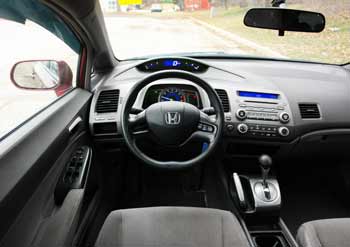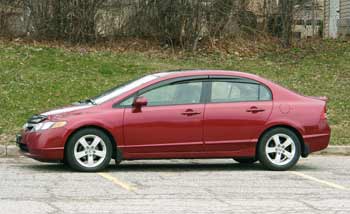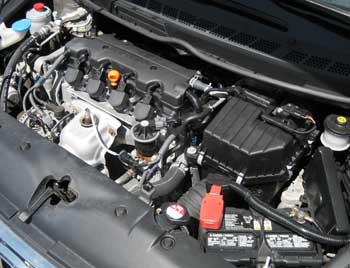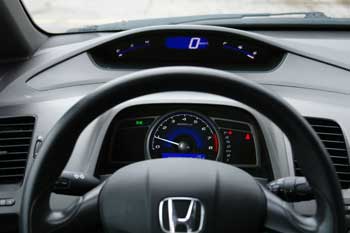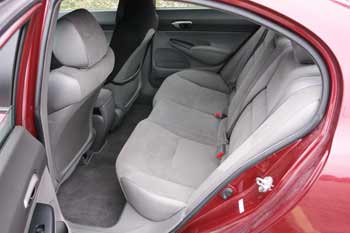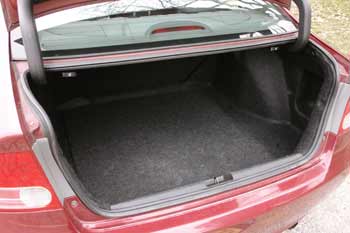Honda Civic 2006-2011: pros and cons, common problems
By Vlad Samarin. Updated: May 07, 2023
The 2006-2011 Honda Civic comes as a sedan or coupe. It's a popular fuel-efficient commuter. With good care it can last for over 300,000 miles. Maintenance and repair costs are low.
The sporty Civic Si comes only with a manual transmission and offers a stronger engine, firmer springs and thicker stabilizer bars.The Civic has front wheel-drive and a sporty rear independent suspension. Inside, the Civic has a two-tier instrument panel with a digital speedometer closer to the view of the road. Is it reliable? What are the reported problems? In this review, we only cover gasoline-powered Honda Civic models.
Pros:
- Low maintenance and repair costs.
- Smaller tires are not too expensive to replace.
- Rear drum brakes can last very long.
- Driving experience.
- Fuel economy.
- Speedometer is close to the view of the road.
- Holds its value well.
- Can last long with good care.
- Low to the ground.
- Small-size battery drains fast and doesn't last long.
- Interior materials could be better.
- Fading clearcoat on some models.
- Road noise.
There are many complaints about a broken or cracked sunvisor. An aftermarket part is sold online for $29-$39. An OEM part is a bit more expensive. The replacement is not very difficult, the sunvisor is held by a couple of screws. We found several YouTube videos describing the repair.
There are quite a few complaints about clearcoat peeling. If the clearcoat is still in good shape in your car, applying car wax at least once a year may help protect it.
A failed thermostat can cause the Check Engine light to come on when the weather gets colder. The scan might reveal the code P0128. The thermostat and its seal will have to be replaced. Parts are not expensive (under $100) and the labor is 1.1-1.5 hours. Watch these videos describing the repair.
A bad transmission fluid pressure switch (3rd clutch) can cause the Check Engine light with the code P0847. The part is not expensive and is not too difficult to replace. Watch these videos on the repair. If the transmission fluid is old or dirty, it's also a good idea to change it.
A faulty wheel bearing can cause a humming noise noticeable at higher speeds that gets louder when changing lanes. Replacing a wheel bearing costs from $250 to $450.
A number of Civic owners mentioned problems with the air conditioner. Some owners said that the A/C clutch or the whole compressor had to be replaced. Replacing just the clutch is cheaper than changing the whole A/C compressor. Watch these videos on A/C clutch replacement. We also found several owners mentioning that a bad A/C relay can cause the A/C compressor not to engage. The A/C relay is an inexpensive part and should be checked first if the A/C is not working. Watch these YouTube videos for more info.
Advertisement
A bad passenger's side hydraulic side engine mount can cause the engine vibration to be felt inside the car, as well as a thumping/clunking noise from the right front side of the vehicle. We found the Honda service bulletin 06-060 "Rattle or Knock From Right-Front of Vehicle When Driving Over Bumps" that advises inspecting the side engine mount for tearing or leaking and replacing it if it's bad. Replacing the side engine mount is not very difficult and may cost from $160 to $320 in a repair shop. Read more about the engine mount.
The Civic's small-size battery can fail after 5 years or earlier; it's not very expensive to replace ( $135-$210).
There have been complaints about a cracked engine block in the 2006-2009 1.8L models. According to this post at Consumer Reports, Honda has extended the engine warranty to 10 years with unlimited mileage. As far as we know, many cars have already been repaired, however, we also found a few recent complaints. One of our friends had the same problem in his 2006 Civic. He had the engine replaced with a used unit, he said it wasn't too expensive and he still drives this car.
Powertrain: The Civic DX, LX and EX trims have a 140-hp SOHC i-VTEC 1.8L (R18) 4-cylinder engine and a 5-speed manual or 5-speed automatic transmission. The Civic Si comes with a 197-hp 2.0L DOHC i-VTEC (K20) inline-4 with a high compression ratio (11.0:1) and, for that reason, requires premium gasoline.
Timing belt or timing chain: Both the 1.8L R18 and 2.0L K20 engines use a maintenance-free timing chain; there is no timing belt.
Fuel Economy: The EPA rates the 2007-2010 Civic with a 1.8L engine and a 5-speed automatic transmission at 25/36 mpg (9.4/6.5 L/100 km) city/highway. This means that you can travel up to 383 miles (616 km) on a 13.2-gallon (50 liter) tank. The 2006-2010 Civic hybrid gets 40/45 mpg. The 2008-2011 Civic Si manual is rated at 21/29 mpg city/highway.
Handling and ride: The Civic handles well, with minimal body roll. The steering is precise and responsive with a tight turning diameter (34.8 ft curb-to-curb). The ride is on the firm side and you can hear some road and tire noise. The 1.8L engine is quick off the line and offers adequate power for daily driving.
Reliability: As of May 2023, Consumer Reports rates the 2006 and 2011 Civic 'above average' for reliability; the 2007-2010 Civic model years are rated 'average'. Two worst-rated areas are Climate System and Paint/Trim.
CarComplaints.com has many reports about a cracked engine block in the 2006 Civic and fewer in the 2007 and 2008 Civic. The 2011 is the best model year.
Overall: Despite the problems mentioned above, the Civic is still one of the top choices for an inexpensive fuel-efficient commuter. Watch this YouTube video of the 2007 Civic hitting 300,000 miles. The Mazda 3 is the closest alternative; it is reliable and offers a sporty driving experience. The Toyota Corolla has a soft and smooth ride and is also reliable, although it's not sporty.
Related reviews:
Toyota Corolla 1998-2008
Honda Civic 2012-2015
Honda Accord 2008-2012
Toyota Matrix 2003-2008
Pontiac Vibe 2003-2010
Chevrolet Cruze 2011-2015
Toyota Corolla 2009-2013
Honda Civic 2001-2005
Mazda 3 2010-2013
Toyota Corolla 2014-2018
What to look for when buying a used Honda Civic: If you want the Civic DX, see if it has the features you need. The air conditioner, power locks, cruise control and even the map lights were not on the list of DX's standard equipment. Check the tires; see if any of the tires appear to be "cupped" or worn unevenly on the inside. During the test drive, watch out for tire noise. Cupped tires can cause a rumbling or humming noise that changes with speed. Check the condition of the sunvisors; they were a weak spot in earlier models. Make sure the air conditioner works; there are many complaints about the A/C working intermittently or not working at all. Read more: How to inspect a used car - illustrated guide. During the test drive of the Civic Si, watch out for a slipping clutch and see how the manual transmission shifts; all shifts should be smooth and easy. Before buying, have the vehicle properly inspected by an independent mechanic. The 1.8L engine needs to be checked carefully for cracks and leaks. It's a good idea to check with a Honda dealer if all the recalls and engine computer software updates have been done. Read also: What mileage is OK for a used car?
Maintenance tips: We checked the owner's manuals for the 2006-2011 sedan models. Honda recommends using 5W-20 oil in the 1.8L gasoline engine (Except Si) and 5W-30 oil in the Civic Si. Regular oil changes will help keep your engine in good shape longer.
The 2006-2011 Civic uses the Maintenance Minder system that calculates oil life based on operating conditions and engine revolutions. When your next service is due, the Maintenance Minder will display a message on the information display. The Maintenance Minder needs to be reset after completing the required maintenance service. You can find the instructions on how to reset the Maintenance Minder in your owner's manual in the Maintenance > Maintenance Minder section.
